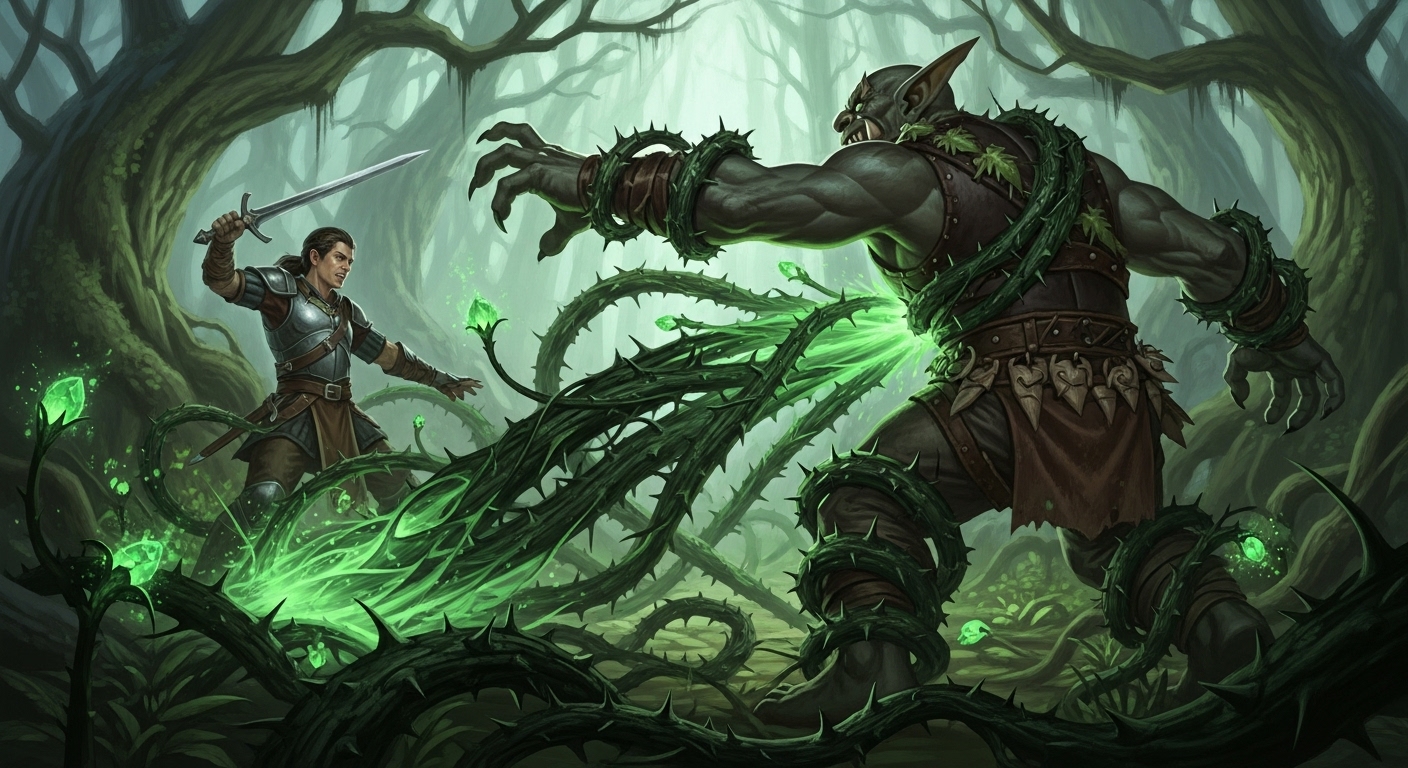Ensnaring Strike

- Level: 1
- School: Conjuration
- Class: Ranger
- Casting Time: Bonus Action, which you take immediately after hitting a creature with a weapon
- Range: Self
- Components: V
- Duration: Concentration, up to 1 minute
As you hit the target, grasping vines appear on it, and it makes a Strength saving throw. A Large or larger creature has Advantage on this save. On a failed save, the target has the Restrained condition until the spell ends. On a successful save, the vines shrivel away, and the spell ends.
While Restrained, the target takes 1d6 Piercing damage at the start of each of its turns. The target or a creature within reach of it can take an action to make a Strength (Athletics) check against your spell save DC. On a success, the spell ends.
Using a Higher-Level Spell Slot. The damage increases by 1d6 for each spell slot level above 1.
Tactical Usage
Nature's Binding: Ensnaring Strike combines weapon attacks with natural restraint effects. This 1st-level conjuration spell excels at immobilizing targets while dealing consistent damage.
Optimal Timing: Use when positioning control is crucial, against high-mobility targets, or when sustained damage over time is beneficial.
Resource Management: Uses a 1st-level spell slot - available from character level 1+. Bonus action casting with 1-minute concentration.
Target Selection: Next weapon attack target becomes entangled by thorny vines on successful hit.
Spell Combinations
Synergistic Spells:
- Damage Enhancement: Combine with hunter's mark for comprehensive damage improvement
- Control Magic: Layer with spike growth to create dangerous movement zones
- Nature Magic: Pair with entangle for enhanced battlefield vegetation control
Class Feature Interactions:
- Fighting Styles: Archery or dueling styles improve weapon attack accuracy
- Hunter Features: Ranger abilities complement natural magic usage
- Favored Enemy: Enhanced attack bonuses improve spell trigger chances
Multi-Caster Coordination: Multiple ensnaring strikes can control different targets simultaneously.
Material Component Details
Component Acquisition: No material components required - only verbal component needed.
Component Handling: Simple verbal casting allows quick battlefield deployment.
Roleplay Opportunities: Different vine manifestations reflect ranger background, regional flora, or natural magical connection.
Economic Considerations: No costs make this economically viable for regular combat enhancement.
Creator Notes
Encounter Balancing: Restraint condition significantly affects enemy mobility and action economy.
NPC Usage: Ranger NPCs or nature-focused enemies might use binding magic for battlefield control.
Environmental Considerations: Natural magic that works well in outdoor environments but functions anywhere.
Campaign Integration: Excellent tactical magic for rangers emphasizing battlefield control and sustained damage.
Environmental Interactions
Terrain Effects: Works in any environment, though natural settings provide thematic enhancement.
Weather Influence: Unaffected by weather conditions, providing reliable control regardless of environment.
Structural Interactions: Vines can manifest even in artificial environments through magical force.
Elemental Interactions: Nature magic generally unaffected by elemental conditions.
Common Rulings & Clarifications
Timing Questions: Bonus action casting with 1-minute concentration. Triggers on next successful weapon attack.
Target Limitations: Single target hit by weapon attack. Strength save to break free each turn.
Duration Interactions: Concentration required. Target takes damage each turn while restrained.
Mechanical Interactions: 1d6 initial damage, ongoing 1d6 piercing damage each turn while restrained.
Alternative Applications
Non-Combat Uses: Restraining fleeing targets, creating temporary barriers, natural demonstration, or wilderness control.
Social Encounters: Intimidation through natural power, demonstrating ranger abilities, or wilderness negotiations.
Exploration Applications: Restraining dangerous creatures, creating temporary holds, or natural obstacle creation.
Utility Functions: Target restraint, natural demonstration, wilderness control, or ranger capability display.
Related Spells
Same School: Other conjuration spells like entangle (1st level area restraint), spike growth (2nd level area control), conjure animals (3rd level creature summoning).
Similar Effects: entangle (1st level area restraint), web (2nd level area restraint), hold person (2nd level humanoid restraint).
Progression Options: ensnaring strike (1st level single target), entangle (1st level area restraint), spike growth (2nd level area control).
Complementary Magic: hunter's mark (damage enhancement), entangle (area control), spike growth (movement punishment).
Scaling Analysis
Level Progression: Remains valuable throughout early-to-mid level campaigns for control and sustained damage.
Upcast Benefits: Additional 1d6 damage per slot level significantly improves effectiveness.
Campaign Phases: Most effective in early-to-mid level play where restraint provides tactical advantage.
Comparative Value: Excellent control magic that combines weapon enhancement with battlefield control.
Narrative Flavor
Casting Description: Natural energy flows through your weapon as your next strike calls forth binding vines to entangle your target.
Effect Manifestation: Thorny vines erupt from the ground to wrap around the struck target, dealing ongoing damage while restricting movement.
Personal Style: Different rangers manifest unique vegetation - forest vines, desert thorns, arctic brambles, or swamp roots.
World Integration: Represents ranger magic connecting weapon combat with natural forces, often associated with wilderness mastery, nature magic, or hunter traditions.